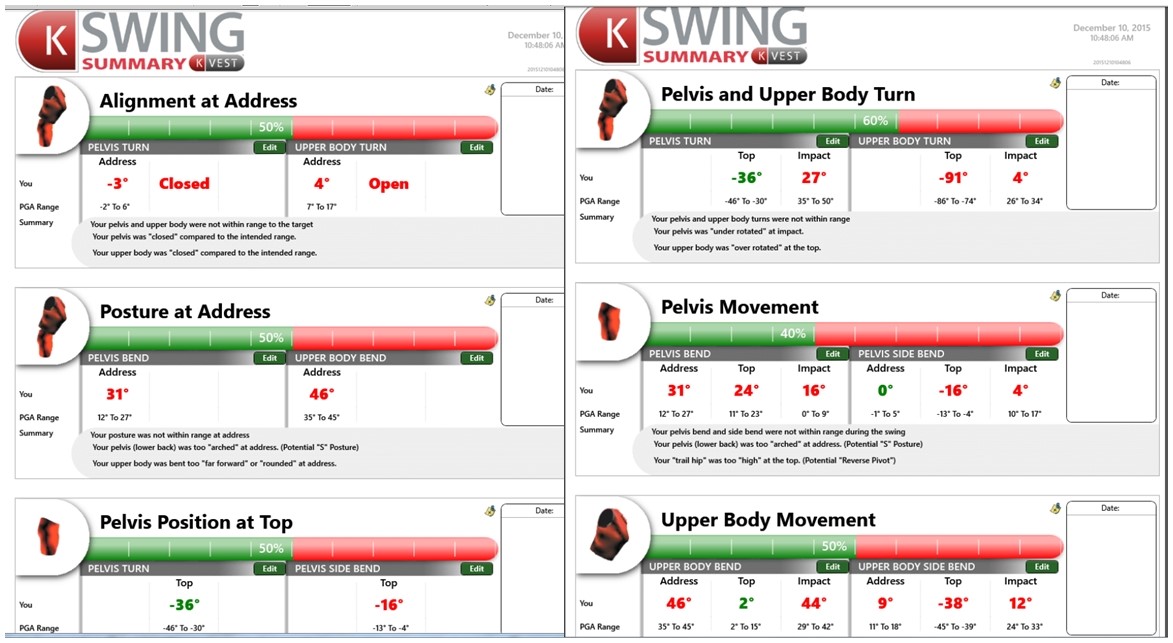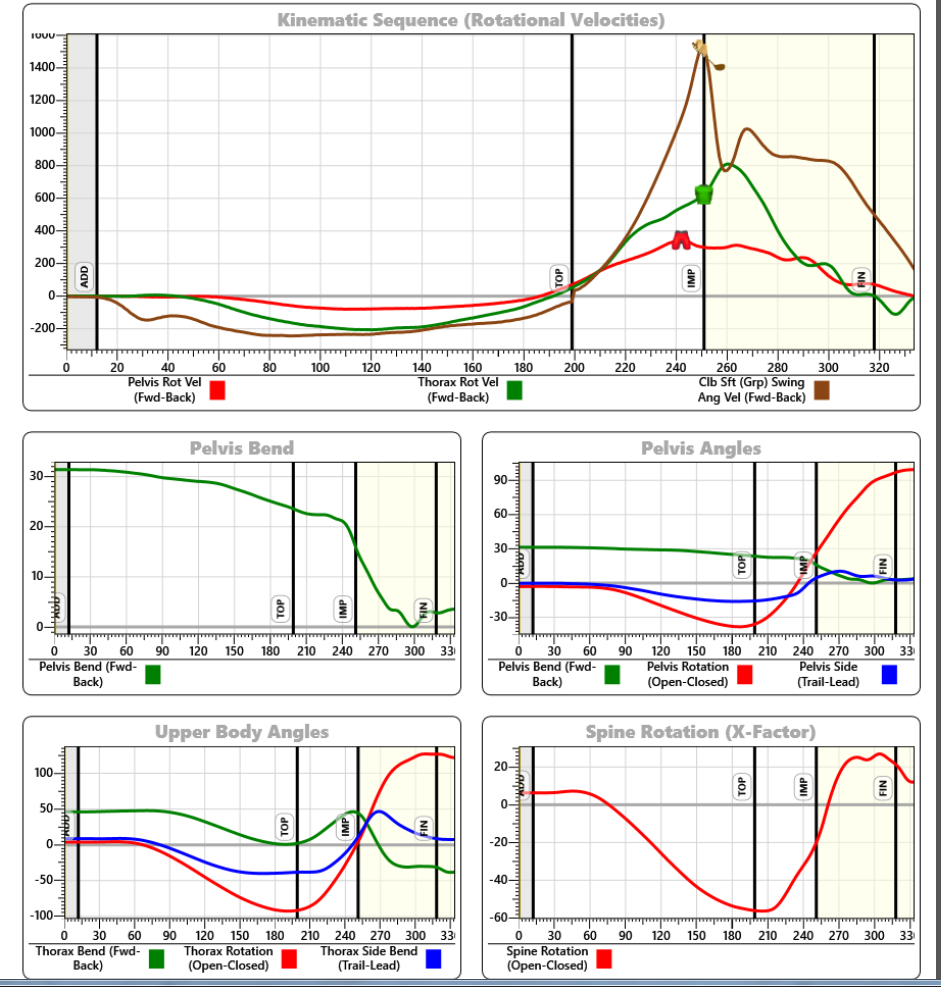By Don Parsons, PGA
 From time to time, other professionals will ask me to take a look at a player’s data and give my opinion on what I see and how I would proceed. This is such a case.
From time to time, other professionals will ask me to take a look at a player’s data and give my opinion on what I see and how I would proceed. This is such a case.
The player in question has been playing for 4-5 years, and shoots between 90 and 100. He is athletic and does well on the majority of the TPI Level 1 screens, with the exceptions of single leg balance and lead side lower body rotation, which is slightly inhibited.
When working with players, I always want to have as much information as possible about their objectives. I want to know their current level of play, their goals, and their level of commitment in time and effort to make the changes I would suggest. The prescription for a collegiate player with All-American aspirations is significantly different than the prescription for a player whose goal is to break 90.
When looking at a player I am concerned with the following:
What is the ball doing and what would the player prefer it to do?
What is the club doing to create the current, undesired ball flight?
What is the body doing and how is it influencing the club to produce the undesired ball flight?
Based on the answers to these three questions, I determine where the best opportunity lies to improve a player’s swing.

As you can see, the player’s ball flight is very low due to a low launch angle, resulting in very short carry distances. Clearly, the player would like to get the ball in the air more effectively and see it travel farther. With his club head speed, it is not unrealistic to expect a driver carry in the 220 yards range and total driving distance in the area of 235 yards.

In the case of this player, his face, path and angle of attack are decent for a player shooting in the 90’s. However, I would expect those delivery parameters to produce a high push. More often, though, he is seeing exceedingly low ball flight and producing lots of snap hooks. Low on-the-toe contact is causing a lot of the problems for this player.
What is starting to become clear is that this player’s low ball flight and poor ball performance are caused by an overly steep vertical swing plane. To improve the launch angle for this player, and to create a higher ball flight, we need to get his vertical swing plane under 50˚, generate more dynamic loft, and more spin loft. Looking at K-VEST data, I will be looking for movement patterns that will allow him to shallow the swing plane and deliver more loft to the ball.

With my initial findings in mind, the next step is to discover their origins in the player’s body movement patterns. While doing this, we want to think about the body orientations this player may employ that will tend to act as shallowing influences.
They are:
- Less rotation with the pelvis and upper body at impact.
–We can see in the data above that the player uses this influence with a 27˚ open pelvis and a 4˚ open upper body; both are well below tour averages but they are the only shallowing influences he currently employs, so they are not something we need to correct at this time.
- More right side bend with the pelvis and upper body at impact.
–We can see that the player is not using side bend as a shallowing method. With pelvis side bend at 4˚ and upper body at 12˚, this presents a great opportunity.
- Less forward bend with the pelvis and upper body at impact.
-We can see that the player has too much forward bend with both the pelvis and upper body at impact with the pelvis at 16˚ and the upper body at 44˚; this also presents an opportunity to improve.
Looking back at the data, we can review the areas that we want to affect with our change. We will work to increase the amount of pelvis and upper body side bend at impact and reduce upper body forward bend at impact. Ultimately, we want to increase rotation of pelvis and upper body. But currently they are the only body orientations this player is using to shallow club delivery.
The orientations that we want to affect at impact are links in a chain. They are determined by what is happening earlier in the swing. The orientations that need correcting begin at set-up and carry through the swing.
Here is the program I recommended:
Increase side bend at address. Pelvis = 4˚. Upper body = 16ᵒ
Work on upper body position at the top. Bend = 8˚ +/- 2. Side bend = – 40˚ +/- 3. (This should result in better loading into the trail leg, and a significant reduction in pelvis side bend at the top. I’d like to see the player’s pelvis side bend at the top in the 8˚-10˚ range.)
Do Dr. Kwon’s step drill to use a little more lateral movement in transition. (Here you want to see that the player creates a right spine tilt by getting his pelvis ahead of his torso.)
When the player is loading into the trail leg and able to hit these numbers, work on clubface control at impact. Utilizing a tennis racket, have the player feel that he is hitting the ball up and right. (His “miss” should be a towering block.)
When the block is happening, you may then have to work pelvis and torso rotations into better range. (If he is athletic, he may figure that out by himself without any input.)

What I have come to understand in the past 10-11 years of using K-VEST is that there is no such thing as a “perfect” graph for everyone. There are Tour Pro Averages that provide great insight. However, making the graphs perfect for a player is no guarantee of ball-striking success. It is also quite possible for great ball strikers to have graphs that aren’t perfect.
What is important to understand is how a player’s motion graphs are interrelated, how they influence the movement of the golf club, and how the movement of the club influences ball flight.
No movement is ever in one plane of motion. If you change one movement pattern, it will change others. As you begin to understand how one change affects other orientations, acceleration rates, and velocities, it becomes easier to change a single parameter that creates positive results throughout the entire swing. It is important to anticipate how changing one parameter will influence every parameter that follows.
Approaching these changes in the proper order can ensure that you are able to help players effectively achieve their objectives. This case study exemplifies My ACT.
Measure
Assess
Coach
Train
The MLB Winter Meetings brings together baseball executives, coaches, media, exhibitors and job seekers from around the world to network, fill job openings, attend educational workshops and discuss innovating trends in the industry. It’s one of the highlights of our…
Agreement to Accelerate Improvement Across All Levels of the Organization (SCOTTSDALE, Ariz.) K-MOTION – the leader in 3D evaluations and biofeedback training solutions for coaches and athletes – announces an agreement with the Baltimore Orioles to become the organization’s Player…
By Joe DiChiara and Jason Meisch You take a swing and don’t like where the golf ball goes. You want to know what happened, so you turn to your launch monitor. You look at the club face numbers. They tell…